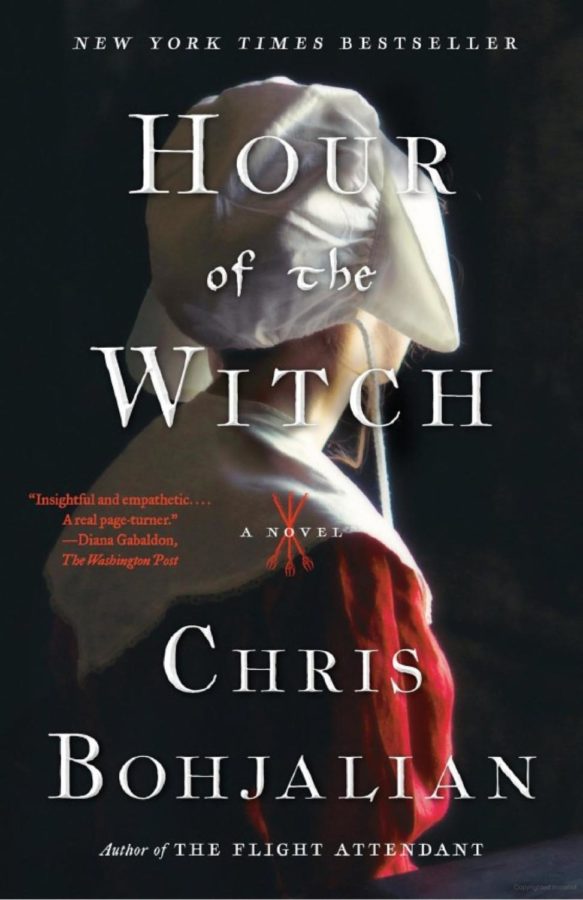Hour of the Witch: Summary and Review
September 30, 2022
This article includes major spoilers.
Hour of the Witch, written by Chris Bohjailan, is a historical, page-turning story that is both suspenseful and relaxing, along with being intellectually enticing. Set in 1662 Boston, Massachusetts, the main character of this eerie story is Mary Deerfield. She is originally from England and has been living with her husband, Thomas Deerfield, the antagonist of the novel, and his indentured servant girl, Catherine. Tolerating abuse from Thomas comes to a halt with one specific incident that leads Mary to fight for her freedom in court. Along with the legal allegations she has pointed toward Thomas, Mary is fearful of the rumors that she has been practicing witchcraft. Throughout the book, you read of Mary’s struggles as she tries to free herself from Thomas and the allegations of being a witch while being judged harshly by her town. This rollercoaster of a story is an excellent example of misogyny, abusive relationships, and strict religious lifestyles in the 17th century.
The book is written from Mary Deerfield’s perspective and starts by telling the story of when her husband started hitting her. He comes home drunk and calls Mary names, saying her mind is nothing but “white meat” and beating her. He only does this in the privacy of their home. Even though people noticed Mary’s bruises in the past, no one thought much of them, painting her as a clumsy woman.
When Thomas came home angry and drunk one night and threw Mary into the hearth, she began to be more afraid of her husband. Later, Mary’s mother gifts her with three-tined forks that her father imported from England. Mary refuses them as they are seen as “the Devil’s tines”’ in her community. Soon after, Mary finds two of the forks buried in front of her house. Wishing to see who placed the satanic offerings in her yard, she reburies them. Catherine finds her doing so and accuses Mary of placing them there herself and of practicing witchcraft. That night, after Catherine flees and Thomas wakes up, he stabs one of the forks into Mary’s hand, breaking the bones. The next day, Mary flees to her parent’s house, telling them everything, and prepares to divorce Thomas.
At this point, we are one-fifth into the novel and our interest is caught. At the time, divorce was uncommon, but a man striking his wife was illegal. Mary has endured abuse from Thomas for almost three years now. Though the abuse is obvious to the readers, it wasn’t seen in public or anywhere besides closed doors, which is true in a lot of abusive relationships. Many of the traits of the abusive relationship in the book are still true today.
When the trial approached, Catherine spoke against Mary, expressing that her master never struck Mary and claiming she fell on a kettle. During the trial, she was also suspected of adultery and witchcraft.
During the trial, the court denies Mary’s request for divorce, and orders her to move back in with Thomas that afternoon. Halfway through the book, misogyny is evident everywhere Mary goes and is a big challenge in court. The jury, made up entirely of men, sees her as a dumb, sinful, lying woman.
Living with Thomas after attempting to gain freedom is unbearable, and Mary is seeking justice. After the first day of the trial, it was suspected by Mary and her parents that Peregrine, Thomas’ daughter from his first marriage, poisoned Hannah, Mary’s parent’s servant girl. Mary is willing to risk poisoning Thomas. Seeking the help of Constance Winston, a spinster that lives on the outskirts of the city who is rumored to be a witch. Mary requests something she could poison Thomas with.
Mary has already been accused of witchcraft because of the forks and the herbs she was using while trying to heal William, Catherine’s brother, before he died. Mary’s friendship with Constance makes it easy for people to believe that Mary is a servant of the Dark Lord because of the rumors associated with Constance.
After Mary gets the poison, she hides it under a loose floorboard. When the time comes to poison Thomas, Mary decides against it.
When she gets home the night before she planned to get on a ship with Henry Simmons, she is greeted by Thomas, and members of their neighborhood gathered around the table with objects that are “evidence” of Mary being a witch.
With less than 70 pages left of the book at this point, this part has us thinking “Go! Get out! Run!” From the beginning, our hopes have been high that Mary leaves Thomas, and in the end, our wish is granted. After enduring a trial for witchcraft, Mary is sentenced to being hanged and has one more night in jail. In the middle of the night, Peregrine and Rebeckah, Mary’s best friend, break her out to help her get on the boat with Henry, who she was previously almost accused of adultery with. On their way, they run into a drunk Thomas. After a tension-filled encounter, Mary and Peregrine kill Thomas with a dagger and leave him to be discovered. We learn that all along Peregrine was the one planting the forks, and had tried to poison Thomas, knowing her father was a monster.
In the epilogue, Mary is safe with Henry and their daughter in England. Thomas is dead and nobody suspects Peregrine.
In my opinion, this is a wonderful ending for a story with as many plot twists and eerie moments as this one. Even with the misogynistic themes represented in the novel, the ending gave empowerment to two women and gave Mary what she deserved. In conclusion, I strongly recommend this book!





























































































































